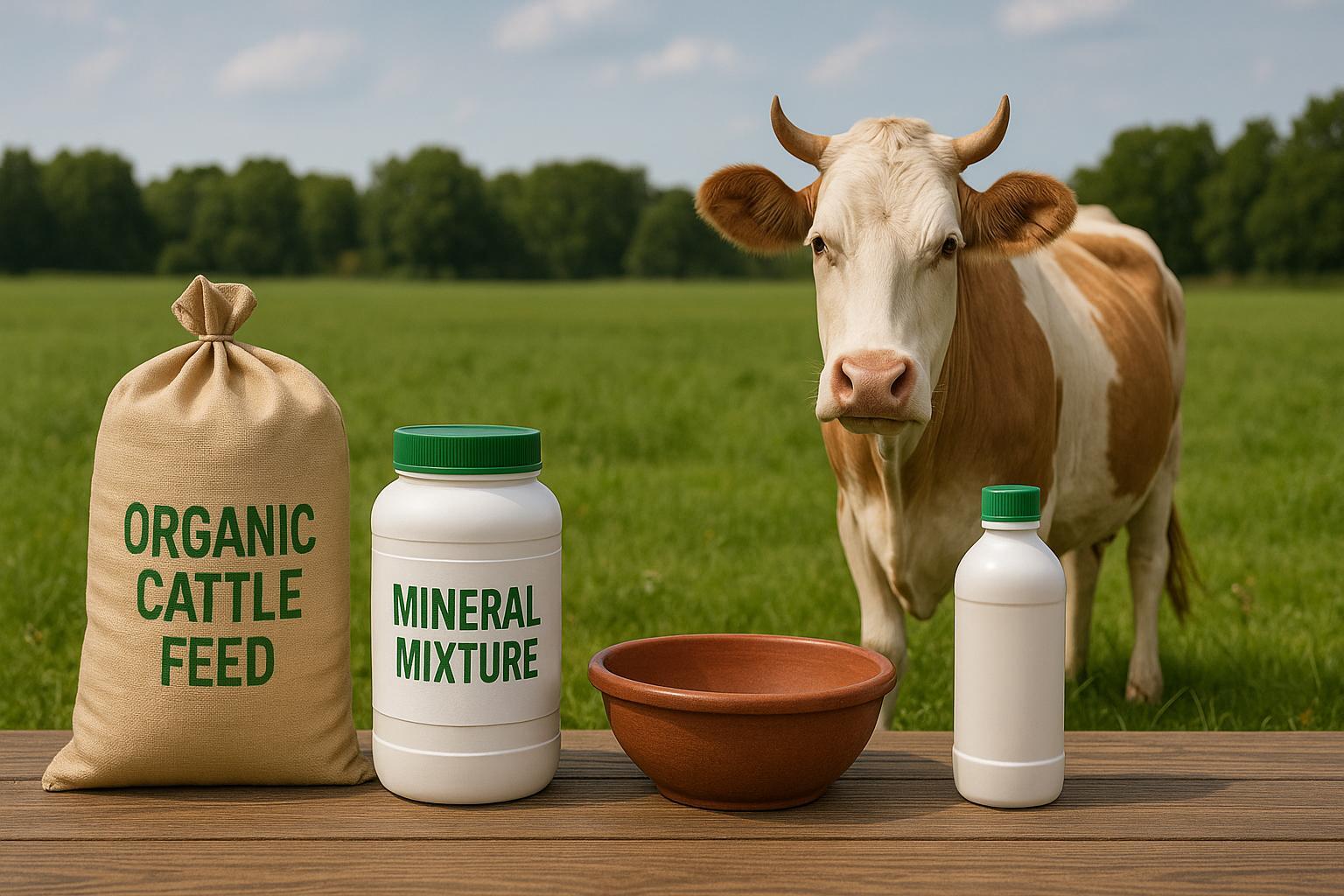Animal Nutrition FAQs: Mineral Mixture Benefits Explained

Animal health begins at the microscopic level, with molecules that regulate growth, energy, reproduction, and immunity. Minerals play a vital role among these. From strengthening bones to supporting enzyme function and boosting fertility, mineral mixtures serve as the backbone of any livestock feeding program. But not every mineral mix fits every animal, and that's where targeted nutrition makes the difference.
In this guide, we answer the most frequently asked questions about mineral mixtures in animal nutrition and offer practical insights into how and why they matter across different livestock systems.
What Are Mineral Mixtures in Animal Nutrition?
Mineral mixtures are feed supplements containing essential macro and trace minerals in precise ratios. They ensure animals meet daily mineral requirements that may not be present in forage or feed.
Key components include:
-
Macrominerals like calcium, phosphorus, magnesium, sodium, and potassium.
-
Microminerals or trace elements include zinc, copper, selenium, iodine, cobalt, and manganese.
These minerals regulate muscle function, nerve transmission, metabolic enzyme activity, and reproductive efficiency.
Most natural feed ingredients do not supply all minerals in the required amount or form. A mixture ensures bioavailability and balances the animal’s diet holistically.
Why Aren’t Natural Feeds Enough?
Forages and grains vary greatly in mineral content depending on soil quality, rainfall, plant species, and processing. For example, grasses grown on acidic soils often lack adequate phosphorus and magnesium.
High-energy feeds may not contain enough trace minerals for proper immune response, hormone synthesis, or hoof integrity. That’s why producers increasingly use fortified formulations or buy Mineral Mixture blends tailored to animal types and lifecycle stages.
These blends are often enriched with chelated minerals or organic forms for better absorption, helping avoid hidden deficiencies that slow productivity and compromise animal welfare.
What Happens When Animals Lack Minerals?
Deficiencies manifest in various visible and invisible ways, depending on which minerals are lacking.
|
Mineral Deficiency |
Common Signs in Animals |
|
Calcium |
Bone weakness, milk fever, poor shell quality |
|
Phosphorus |
Pica (eating soil), low conception rates |
|
Zinc |
Rough coat, skin lesions, poor wound healing |
|
Copper |
Depigmentation, poor wool, anemia |
|
Selenium |
White muscle disease, infertility |
|
Iodine |
Goiter, stillbirths, weak offspring |
Deficiencies reduce production metrics, leading to higher veterinary costs and reduced herd longevity.
How does Animal Type customize Mineral Mixtures?
Different species and life stages require different mineral profiles. A blanket mixture cannot equally serve growing calves, high-yielding dairy cows, and pregnant goats.
Species-specific formulation examples:
-
Dairy Cattle: Higher calcium and phosphorus during lactation, magnesium to prevent tetany, plus selenium and vitamin E to support udder health.
-
Goats: Copper and manganese for fiber quality, calcium for pregnancy support.
-
Poultry: Manganese, zinc, and calcium for eggshell strength; iodine for thyroid function.
-
Swine: Phosphorus, zinc, and selenium for muscle growth and reproductive efficiency.
Mineral ratios must also match the local feed base. For instance, a maize-based diet may require additional zinc and calcium to balance its high energy-to-mineral ratio.
How Do Mineral Mixtures Improve Fertility?
Reproductive health is susceptible to mineral status. Trace elements directly influence hormone regulation, embryo viability, and semen quality.
Key fertility-related minerals:
-
Zinc: Supports testicular development and sperm viability.
-
Selenium: Prevents embryonic death and enhances uterine tone.
-
Copper: Influences ovulation and estrus cycle regularity.
-
Iodine: Crucial for thyroid regulation and fetal growth.
Livestock that maintains adequate mineral levels have stronger offspring, better conception rates, and shorter calving intervals.
Can Mineral Mixtures Boost Milk and Meat Yield?
Yes. Minerals support protein synthesis, calcium metabolism, and immune resilience, all of which influence output. Studies show that herds receiving balanced minerals can increase milk yield by up to 15% and reduce somatic cell counts, indicating improved udder health.
Optimal zinc and phosphorus improve muscle deposition and reduce stress-related losses in meat animals like broilers or lambs. Balanced iron and copper intake also enhances blood oxygen transport, supporting endurance and growth.
A study published in the Journal of Animal Science and Biotechnology found that cattle supplemented with trace mineral premixes had 10% better average daily gain (ADG) than their non-supplemented counterparts.
How Are These Minerals Absorbed?
The gastrointestinal environment and the type of mineral determine its bioavailability. Although they are frequently found, inorganic forms like as oxides and sulphates frequently have low rates of absorption. Better absorption is provided by organic or chelated minerals (bound to amino acids), particularly in times of illness or stress.
For young animals or those fed a lot of grains, chelated versions of copper, zinc, and manganese work very well. They more effectively reach absorption sites and do not interact with anti-nutritional forces.
Using a blend of inorganic and organic sources ensures both cost-effectiveness and performance.
“A mineral's value isn’t in its presence—it’s in its absorption. You can feed tons of nutrients, but only absorbed ones impact your animal’s health.” — Dr. H.L. Katoch, Ruminant Nutrition Expert.
Should Mineral Mixtures Include Vitamins?
Yes. Vitamins and minerals often work in synergy. For example, Vitamin D supports calcium metabolism, Vitamin E enhances selenium’s antioxidant effect, and B-complex vitamins support energy metabolism.
Comprehensive premixes often contain:
-
Vitamin A for vision and immunity
-
Vitamin D3 for bone health and egg production
-
Vitamin E for muscle tone and reproduction
-
Vitamin B12 for red blood cell formation
Inclusion depends on the species, purpose (growth, reproduction, lactation), and feed base.
What Should Farmers Look for in a Quality Mineral Mix?
When choosing a mineral mixture, farmers should evaluate:
-
Bioavailability (chelated vs inorganic forms)
-
Correct ratios of macro to trace minerals
-
Inclusion of species-specific additives
-
Compliance with local nutritional standards
Labels should list all components with exact concentrations. Avoid vague terms like "trace minerals added" without specifics.
Storage stability should also be considered, especially for elements like Vitamin A and selenium, which degrade under heat or moisture.
FAQs
-
Can I give the same mineral mix to different species on my farm?
No. Each species has unique needs. For example, sheep are susceptible to copper, which is necessary for cattle. Always use species-specific formulations. -
How often should mineral mixtures be given?
Daily through feed or free-choice supplements. Consistency is key to preventing deficiencies. -
Is over-supplementation a problem?
Yes. Excess minerals like copper or selenium can be toxic. Follow recommended dosages and consult a nutritionist for customized feeding plans. -
Are lick blocks as effective as powder or premix forms?
Lick blocks are helpful in grazing animals but lack precision. Premixes added to feed ensure controlled intake. -
Do mineral mixtures replace antibiotics or vaccines?
No. Minerals are preventive tools. While they strengthen immunity, they do not treat infections. However, they do reduce dependency on curative treatments by enhancing resilience.
What Are the Economic Benefits?
Balanced mineral nutrition saves money in the long run. Reduced disease outbreaks, better growth rates, improved reproduction, and higher product quality translate into more substantial profit margins.
For instance:
-
A dairy cow producing 1 liter more milk per day due to improved nutrition yields an extra 300+ liters annually.
-
Broilers with optimized mineral intake reach market weight 4–5 days earlier, saving feed costs.
Mineral mixtures deliver high returns on a relatively low investment by minimizing health risks and maximizing output.
What Trends Are Emerging in Mineral Supplementation?
The industry is moving toward precision nutrition. Emerging innovations include:
-
Nanominerals for higher bioavailability at lower doses.
-
Smart dispensers that monitor animal intake.
-
Probiotic-enhanced mineral supplements for gut health synergy.
-
AI-based ration formulation tools integrating mineral diagnostics.
There’s also growing interest in region-specific formulations based on soil mineral mapping, ensuring more accurate supplementation.
For more on current livestock nutrition technology, the International Feed Industry Federation offers a comprehensive overview of feed sector trends.
How Can Farmers Monitor Mineral Needs?
Regular testing is crucial. Key monitoring methods include:
-
Blood serum tests for calcium, phosphorus, selenium.
-
Milk testing for somatic cell count and mineral levels.
-
Feed and forage analysis to identify mineral gaps.
-
Manure sampling to detect excess excretion.
These tools help adjust mineral strategies based on actual uptake, not just assumptions.
Who Should Design My Mineral Plan?
Work with an animal nutritionist or veterinarian who understands regional deficiencies, breed-specific needs, and feed interactions. Many feed suppliers also offer formulation services or mobile apps for farmers.
Beyond the Basics
Mineral combinations are strategic tools in contemporary livestock production, not just supplements. They increase profitability, resilience, and productivity when properly developed and applied.
Livestock nutrition will become more individualised, data-driven, and sustainability-oriented in the future. The proper minerals are at the core of it all, quietly yet effectively influencing animal results.






